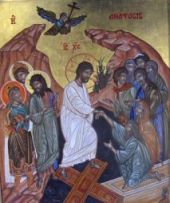It was fitting that the Architect of the works of creation should come and raise up the house that had fallen and that the hovering Spirit should sanctify the buildings that were unclean. Thus, if the Progenitor entrusted the judgment that is to come to his Son, it is clear that he accomplished the creation of humanity and its restoration through him as well. He was the live coal, which had come to kindle the briars and thorns. He dwelt in the womb and cleansed it and sanctified the place of the birth pangs and the curses. The flame, which Moses saw, was moistening the bush and distilling the fat lest it be inflamed. The likeness of refined gold could be seen in the bush, entering into the fire but without being consumed. This happened so that it might make known that living fire which was to come at the end, watering and moistening the womb of the Virgin and clothing it like the fire that enveloped the bush.
Ephrem the Syrian, Commentary on Tatian’s Diatessaron I.25, quoted in Arthur A Just (ed), Luke, Ancient Christian Commentary on Scripture, New Testament III, (Intervarsity Press, 2003) 18-19.
Cardinal Newman in his admirable “Letter addressed to the Rev. E.B. Pusey, D.D., on occasion of his Eirenicon” (1865) says very aptly: “Theology is concerned with supernatural matters, and is ever running into mysteries, which reason can neither explain nor adjust. Its lines of thought come to an abrupt termination, and to pursue them or to complete them is to plunge down the abyss. St. Augustine warns us that, if we attempt to find and to tie together the ends of lines which run into infinity, we shall only succeed in contradicting ourselves…” (Difficulties felt by Anglicans in Catholic Teaching, 5th ed., page 430). It is widely agreed that the ultimate considerations which determine a true estimate of all particular points of the Christian tradition are doctrinal. No purely historical arguments, whether from antiquity or from silence, are ever decisive. They are subject to a further theological scrutiny and revision in the perspective of the total Christian faith, taken as a whole. The ultimate question is simply this: does one really keep the faith of the Bible and of the Church, does one accept and recite the Catholic Creed exactly in that sense in which it had been drafted and supposed to be taken and understood, does one really believe in the truth of the Incarnation? Let me quote Newman once more. “I say then,” he proceeds, “when once we have mastered the idea that Mary bore, suckled and handled the Eternal in the form of a child, what limit is conceivable to the rush and flood of thoughts which such a doctrine involves? What awe and surprise must attend upon the knowledge, that a creature has been brought so close to the Divine Essence?” (op. cit., page 431) Fortunately a Catholic theologian is not left alone with logic and erudition. He is led by the faith; credo ut intelligam. Faith illuminates the reason. And erudition, the memory of the past, is quickened in the continuous experience of the Church.
Georges Florovsky, Creation and Redemption(Nordland Publishing Company, 1976) 185-186.




